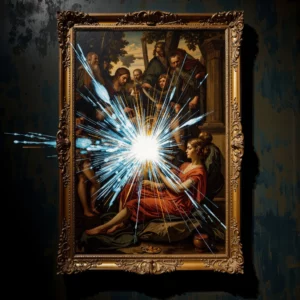 The Louvre’s seemingly simple gesture of acquiring its first work of video art marks a turning point in the complex dynamics between cultural institutions and technology. The work ‘Les 4 temps’ by Algerian artist Mohamed Bourouissa is not just an addition to the Parisian museum’s permanent collection, but represents a redefinition of the traditional boundaries of institutional art. (Source 1)
The Louvre’s seemingly simple gesture of acquiring its first work of video art marks a turning point in the complex dynamics between cultural institutions and technology. The work ‘Les 4 temps’ by Algerian artist Mohamed Bourouissa is not just an addition to the Parisian museum’s permanent collection, but represents a redefinition of the traditional boundaries of institutional art. (Source 1)
This symbolic event raises a fundamental question: who controls the territories of artistic expression and technology today? And how are these territories being contested, subverted, or legitimized?
The Institution Opens Up: Permeable Boundaries Between Digital and Tradition
The collaboration between the Louvre and Bourouissa began in 2024 when the museum entrusted the artist with managing its Instagram account. For 52 consecutive weeks, every Sunday, Bourouissa published a video documenting the life of the Tuileries Gardens through the seasons. (Source 7)
This experimental approach highlights how even the most conservative institutions are reconsidering their relationship with digital media. It is no longer a simple communication strategy, but a recognition of the intrinsic artistic value in new expressive languages.
The acquisition of ‘Les 4 temps’ thus represents a paradigm shift in the way traditional museums interact with contemporary art and its expressive means. Video is no longer considered merely as documentation or a promotional tool, but as an autonomous work of art worthy of being preserved alongside historical masterpieces.
Technological Subversion: When Digital Art Challenges Established Power
While the Louvre officially embraces video art, other artists are using emerging technologies to directly challenge institutional narratives. A significant example is the unauthorized project by 17 indigenous artists who used augmented reality to transform works displayed in the American wing of the Metropolitan Museum. (Source 5)
Launched symbolically on Indigenous Peoples’ Day, this initiative overlays native interpretations onto works that have historically represented indigenous peoples through a colonial gaze. AR technology thus becomes a tool of cultural reappropriation and political contestation.
Similarly, artists Tega Brain and Sam Lavigne use digital tools to “distract” executives of fossil fuel companies, engaging the public in a form of technological activism against climate change. Their exhibition at Pioneer Works in New York transforms interactive art into a tool of creative resistance. (Source 2)
Technological Sovereignty: Geopolitics Enters Digital Art
These artistic examples are part of a broader context of geopolitical tensions related to technology. OpenAI’s recent move to announce “AI sovereignty” partnerships with governments around the world reflects a new phase in the technological competition between the United States and China. (Source 3)
The issue of digital sovereignty concerns not only nation-states but also cultural institutions and artists. Who controls the tools of digital artistic production? How are these tools distributed, and under what conditions?
Meta, for example, is pushing its employees working on the metaverse to use artificial intelligence to “go 5 times faster,” as part of a strategic shift within the company. (Source 8) This technological acceleration has profound implications for the future of digital art creation.
In parallel, the XR (Extended Reality) industry continues to evolve rapidly, with Valve increasing production of the Steam Frame, Apple prioritizing smartglasses, and Lynx presenting its next mixed reality headset for professional users. (Source 4, Source 6)
These technological developments are not neutral; they embody specific political and economic visions that deeply influence the expressive possibilities of digital artists.
Toward a New Ecology of Technological Art
The acquisition of ‘Les 4 temps’ by the Louvre, the unauthorized AR interventions at the Met, and the activist projects of Brain and Lavigne represent different strategies for negotiating with existing institutions and emerging technologies.
These artistic practices invite us to imagine a new ecology of technological art that is neither completely absorbed by traditional institutions nor entirely dependent on commercial platforms.
The challenge for artists, institutions, and the public is to develop forms of creative sovereignty that allow for meaningful artistic expressions within an increasingly complex and contested technological ecosystem.
In this context, Bourouissa’s video art at the Louvre, the AR interventions at the Met, and the activist projects of Brain and Lavigne are not simply isolated artworks, but represent attempts to redefine the boundaries between art, technology, and power.
As geopolitical tensions around AI and the metaverse continue to intensify, artists working with new technologies find themselves in a unique position to contest, subvert, or reimagine these contested territories.
References:
- Per la prima volta il Louvre mette in collezione permanente un’opera di videoarte
- These artists want your help distracting fossil fuel executives
- ‘Sovereign AI’ Has Become a New Front in the US-China Tech War
- The XR Week Peek (2025.10.13): Valve is ramping up the production of Steam Frame, Apple is prioritizing smartglasses, and more!
- Indigenous artists transform works at Metropolitan Museum in unsanctioned augmented reality project
- Lynx Teases Next Mixed Reality Headset for Enterprise & Professionals
- Louvre acquires first-ever video work
- Meta Tells Its Metaverse Workers to Use AI to ‘Go 5X Faster’
This essay was generated using an artificial intelligence workflow designed and supervised by Enzo Gentile. The sources were selected and analyzed automatically, and the final text was critically reviewed before publication.